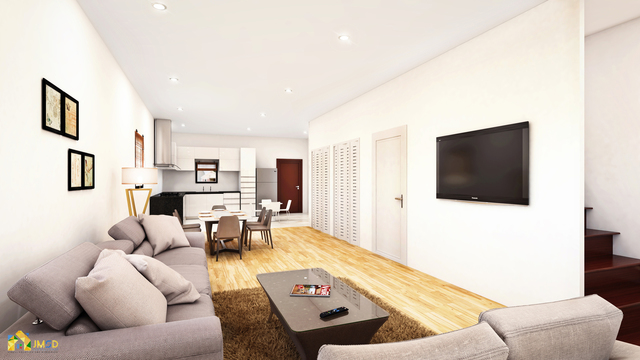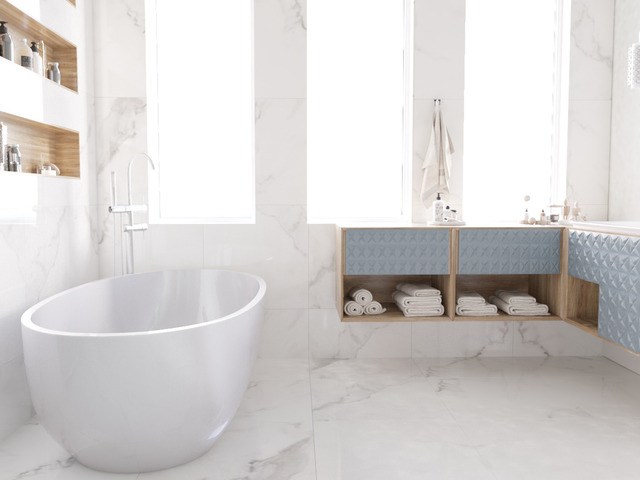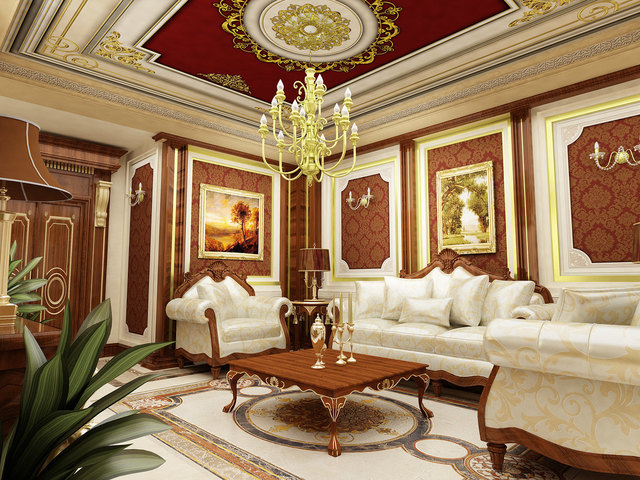3D rendering services are hugely popular and are seeing wide-spread usage in many industries. Designers now have access to advanced 3D rendering software like SolidWorks, CATIA, and Maxwell Render that allow them to produce detailed 3D models and 3D renders. Using this software, they can create photorealistic images—i.e. the render is indistinguishable from a photograph.
One particular industry that 3D rendering services are beneficial in is real-estate. Real estate agents must promote their properties and show them in a favorable light. This is relatively easy for standard properties that are already built. But what about pre-sale properties?
In this article, we look at how 3D rendering is used in real-estate. Moreover, we discuss specifically how it can help real-estate developer’s pre-sell properties:
 Table of Contents
Table of Contents
- How the pre-sale of properties works
- Benefits of using 3D rendering services for pre-sale properties
- Allow customers to see the potential benefits of a property
- Provides an emotional connection
- Customers can preview the property before it is constructed
- 3D renders can be used in pre-sale marketing campaigns
- It gives weight to realistic pricing of pre-sale developments
- Helps tell a visual story
- Improves flexibility for creating different content
- Allows you to disclose additional details
- Help customers visualize a property through realistic 3D renders
How the pre-sale of properties works
First, let’s look at the concept of pre-sale. This is a common practice within the property industry, especially for large developments like housing estates or apartment blocks. Essentially, the freelance construction design service will commence construction of the property and list it for sale before it’s completed.
This could be done at various stages of development. For example, it’s not uncommon for developers to list properties when they are still in the design stages, and the physical site is still being excavated.
Pre-sale deals often include incentives that make the purchase look increasingly attractive to potential buyers. For example, discounts on the purchase price may be offered, or discounts on the interior and furnishings.

Why do developers offer pre-sale? Simply to help with cash flow. Funding new construction projects is hugely expensive—companies must have a lucid cash flow to ensure they can purchase the required materials, pay for planning, and labor, etc.
Furthermore, they may require cash to fund future projects. This is why pre-sale is so important—the funds they acquire can be used to ensure the project runs smoothly and to allow the business to develop.
RELATED: 7 benefits of 3D architectural rendering services for real estate
3D rendering can greatly improve pre-sale marketing and promotion as you will see below. Customers don’t want to see images of an empty building plot, or the concrete foundations of a building. They want to see the finished product so they know what they’re buying.
Benefits of using 3D rendering services for pre-sale properties
Now that you understand a little about the pre-sale process, we can look at how 3D rendering fits into the equation. As mentioned above, the main issue with pre-sale properties is that the customer can’t visit the plot and they can’t see actual photos of the completed building.
This creates an issue when producing promotional material. Therefore, 3D rendering is so important—particularly photorealistic 3D rendering that can recreate properties that look indistinguishable from the real thing. The following are some of the main benefits 3D renderings and freelance architectural planning and design services provide for real estate agents engaged in pre-sale developments:
Allow customers to see the potential benefits of a property
This is a simple but important pointer. When purchasing a property, customers want to list its benefits. They want to consider different questions and find the answers when looking at a property. Could we fit two sofas in the living room? Is the en-suite bathroom large enough? Will our children have enough room to play and have fun?
Creating 3D interior rendering designs of a pre-sale property allows customers to answer these questions and list the potential benefits. It helps create a positive reaction and shows potential buyers what they could gain from making the pre-sale purchase.
Provides an emotional connection
Buying a property is one of the biggest decisions people make during their lives. It is often said that customers are more willing to purchase if they have an emotional connection with the property.
Can you create an emotional connection with a plot of land or a construction site? Using 3D rendering helps stir the emotions of buyers and generate those feelings of elation and excitement.
Customers can preview the property before it is constructed
This is the obvious benefit. Imagine this scenario—you want to purchase a new house and you find a plot you like and book a viewing. You explore the house and form a mental picture of what living there would be like.
Consider this same experience for a pre-sale development. You find a plot you like and book a viewing.

You enter the construction site and see a mass of concrete and steel—not particularly inspiring, is it? Customers want to try before they buy—this is a basic marketing principle. 3D rendering allows the photorealistic rendering service to give customers that preview—you can produce photorealistic renders of the property so that customers have something to visualize—not just an empty building plot.
3D renders can be used in pre-sale marketing campaigns
Aside from creating web content to showcase pre-sale development, it is also important to produce marketing material for distribution. There are a plethora of potential media outlets that can be used to promote your pre-sale development. Using photography, your marketing will look plain and lack substance.
However, creating 3D renders of the property provides you with brilliant and exciting marketing material. You can enhance your leaflets and adverts with a beautiful 3D render of the development—this will create a better response and generate greater interest from potential buyers.
It gives weight to realistic pricing of pre-sale developments
A potential barrier when marketing pre-sale properties is justifying the sale price. How can you put a realistic price on a property that hasn’t been built? Regardless of the quality of the build, the materials used, and the monetary value of the finished property, convincing customers your empty plot of land is worth that sum is quite difficult. Potential buyers struggle to see past the vacant plot of land, or the half-built condo—this can often lead to poor sales or frequent price reductions due to lack of interest.
This can be avoided using 3D rendering. Using a freelance achitectural site planner, you can show and justify the value of the property. Those fine details and finishing touches that help show value can be display digitally. This gives weight to your pricing and helps customers perceive the price tag of the pre-sale development.
Helps tell a visual story
When potential buyers look at a property, they must be able to visualize themselves living there. They want to create a story and scenarios that they may play out in the future. For example, they may want to picture themselves enjoying a family meal in their dining room or cooking a special meal in the kitchen. Can this realistically be achieved via photos of an in-progress construction site? Or an empty building plot? Of course not!
3D real estate rendering services allows real estate agents to create a visual story. They can create a myriad of different 3D images depicting different scenes in the property. Furthermore, they can add small details to make the property look lived-in. These small details and visual treats allow customers imagination’s to run wild. They build a story and help potential buyers picture themselves living in that property.
Improves flexibility for creating different content
Having a flexible marketing strategy in the real estate industry is important. You must be able to keep marketing fresh, up-to-date, and original. Furthermore, you must be able to react to customers’ needs and their changing buying habits. This is vital for pre-sale development.
As mentioned before, you are trying to promote a blank canvas plot. Potential buyers of pre-sale properties would expect flexibility in what they purchase. The property isn’t built; therefore, they expect it to be molded as they see fit. 3D rendering provides that flexibility.

For example, using 3D architectural visualization services, you could create several variations of the same property design with different furniture, work surfaces, and fixtures. You may offer a range of fixtures and furniture packages, for example.
Potential customers don’t want to see just one variant—they want to visualize each iteration of the property offered; 3D rendering makes this possible! Furthermore, this can be achieved quickly—providing that the original renders are saved, they can be edited and details changed relatively easily.
Allows you to disclose additional details
One of the main problems with pre-sale properties is the lack of detail and information. Traditionally, a real estate firm could provide basic 2D floor plans, and maybe a link to Google Maps showing the development plot. Furthermore, they may provide a list of details and specifications of the property. This could include the number of rooms, room dimensions, and floor area, for example.
RELATED: The benefits of 3D architectural rendering for companies in the real estate industry
For potential buyers, this isn’t much to consider. How could someone realistically consider making a purchase based on text lists and generic floor plans?
3D architectural rendering services allow a real estate agent to provide so much more information and details. For example, 3D renders of the property can be equipped with digital furniture, accessories, and wallpaper/paint. You can create a finished product that has all the details a physical property development would have. In addition to this, you can include exterior details like a garden, and even digital impressions of the surrounding area.
This level of additional detail improves the pre-sale listing and gives it a sense of realism that customers can buy into.
Help customers visualize a property through realistic 3D renders
Never before have real-estate agents had tools like this to help promote their property portfolios. Pre-sale developments are often only marketed by the developer. By utilizing residential 3D rendering, real estate businesses can improve their ability to promote pre-sale developers and add this niche to their portfolio.
As a business, you can’t underestimate the importance and value that 3D rendering has. This type of digital design gives you so much flexibility—you can improve your digital content indefinitely. Furthermore, you can effectively market properties that you couldn’t using traditional photography.
If you are a real estate business, why not check out the services that Cad Crowd provides? We work with a myriad of professional 3D render specialists. Using our platform, you can find suitable 3D designers who can take your marketing and digital content to the next level! Get a free quote today.
